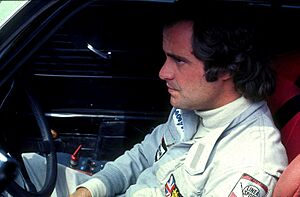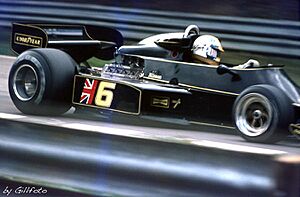Gunnar Nilsson facts for kids

Nilsson in 1976
|
|
| Born | 20 November 1948 Helsingborg, Sweden |
|---|---|
| Died | 20 October 1978 (aged 29) Hammersmith, London, England |
| Formula One World Championship career | |
| Nationality | |
| Active years | 1976–1977 |
| Teams | Lotus |
| Entries | 32 (31 starts) |
| Championships | 0 |
| Wins | 1 |
| Podiums | 4 |
| Career points | 31 |
| Pole positions | 0 |
| Fastest laps | 1 |
| First entry | 1976 South African Grand Prix |
| First win | 1977 Belgian Grand Prix |
| Last win | 1977 Belgian Grand Prix |
| Last entry | 1977 Japanese Grand Prix |
Gunnar Axel Arvid Nilsson (born November 20, 1948 – died October 20, 1978) was a Swedish racing driver. He became famous for his skills on the track. Before he joined Formula One, he won the 1975 British Formula 3 Championship.
Gunnar Nilsson took part in 32 Formula One Grand Prix races. He managed to qualify for every single one. His biggest win was the 1977 Belgian Grand Prix at Zolder. He was driving for the Lotus team at the time. After leaving Lotus, he planned to race for Arrows in 1978. However, he was diagnosed with cancer and could not drive. He also competed in three International Race of Champions (IROC) races in 1977. He finished fifth once and sixth twice.
When he learned his cancer was very serious, he created the Gunnar Nilsson Cancer Foundation. He passed away in October 1978.
Contents
Becoming a Racing Driver
Gunnar Nilsson was the second son of a builder in Helsingborg, Sweden. He studied engineering at Stockholm University for four years. After getting his degree, he worked in construction for a short time.
But Gunnar was not interested in building. He wanted to race cars. He started a successful transport business with a friend, Dan Molim. Even when he became a full-time driver, he remained a partner in this company. He was inspired by other Swedish racers like Ronnie Peterson and Reine Wisell. He knew he wanted to be a racing driver too.
Starting His Racing Career
Gunnar began racing in Sweden in the late 1960s. In 1972, he bought a Formula Vee car to learn how to race. He competed ten times that season and won one race at Mantorp Park.
In 1973, at age 26, he moved up to the Formula Super Vee series. He raced with the Ecurie Bonnier team. He learned a lot from his experienced teammate, Freddy Kottulinsky. Gunnar finished third in his first race and ended up fifth in the championship. He was clearly talented.
He then moved to Formula Two. He finished fourth in a race at the Norisring. This showed he could compete at a higher level. He realized his next step should be Formula Three. A company called Västkust-Stugan offered to sponsor him for 1974.
Success in Formula Three
With Västkust-Stugan's help, Gunnar got a March 743 car for the Polifac Formula Three Championship. He earned some second-place finishes. He also had a few spins and small accidents as he learned.
His strong performances caught attention. He was given a chance to drive for the March team in the British series in 1975. This was a big step for him.
Having more practice and confidence, Gunnar won his first F3 race at Thruxton. This win started a great run of success. He went on to win the B.A.R.C. BP Super Visco British F3 Championship. He also won races at Aintree, Ring Knutstorp, Snetterton, and Silverstone.
His success in F3 and Formula Atlantic caught the eye of Ted Moore. Ted signed Gunnar to race his Formula Atlantic car. Gunnar won five races in a row, starting from the front of the grid four times.
His great driving earned him a test in a Formula One car at Goodwood in late 1975. He did very well and was offered a contract for 1976. However, he turned it down for a Formula Two drive that didn't require him to pay. But then, his fellow Swede, Ronnie Peterson, decided to join March in Formula One. As part of that deal, March offered Gunnar to the Lotus team. This is how Gunnar Nilsson joined Formula One.
Formula One Career
Gunnar Nilsson only raced for Colin Chapman's Team Lotus during his Formula One career. He got his chance when other drivers left the team. The new Lotus car for 1976, the Lotus 77, looked promising. The team was changing a lot, and Mario Andretti soon joined. Gunnar learned a lot from Andretti's experience.
Gunnar's first race was the 1976 South African Grand Prix. It was a tough start; he qualified last. His car even caught fire during practice. His next race, the non-championship Race of Champions, was better. He started near the front and took an early lead, but his engine had a problem. In the US GP West, he crashed at high speed after his rear suspension broke.
Despite these challenges, his first season had some good moments. He finished third at the Gran Premio de España, which was only his third Grand Prix. He also got another third place in the Grand Prix von Österreich. He finished fifth in Germany and sixth in Japan. However, the rest of the season was difficult, with many accidents and car problems.
For 1977, Lotus kept Gunnar Nilsson and Mario Andretti. They worked on developing the new Lotus 78 car, which used a special "ground-effect" design to go faster. After a slow start, Gunnar began to perform well. He finished fifth at Jarama.
Two races later, he achieved a fantastic win at the rainy Zolder track. As the race went on and the track dried, Gunnar had to stop for a tire change. With new tires, he drove past Niki Lauda's Ferrari with 20 laps left. He held the lead and won the race! He also had good results at Dijon-Prenois (fourth) and Silverstone (third). This helped him climb the championship standings.
Towards the end of the 1977 season, his performance dropped. He retired from the last seven races. His relationship with team boss Colin Chapman also became difficult. Ronnie Peterson was set to return to Lotus, so Gunnar was leaving the team. By this time, he was already feeling the first signs of cancer. He finished the season in eighth place with 20 points.
Gunnar signed to race for Arrows in 1978, their first season. But he was too unwell to drive and had to step down. Rolf Stommelen took his place. While Gunnar became weaker, Mario Andretti and Ronnie Peterson raced for the World Championship.
Racing Outside Formula One
Gunnar Nilsson was a versatile driver. He also raced BMW saloon cars in sports car championships in 1976 and 1977. In 1977, he teamed up with Dieter Quester in a BMW-Alpina. They won races at Salzburgring and Nürburgring.
He also tried American oval racing in the International Race of Champions series. He finished fifth at Michigan and sixth twice at Riverside in 1977. He really enjoyed this type of racing.
His Fight with Cancer
In December 1977, during a regular check-up in London, Gunnar Nilsson found out he had cancer. From that moment, his health quickly got worse. He received intense treatment at Charing Cross Hospital in London. By July 1978, he had lost a lot of weight and all his hair. But he still talked about possibly returning to racing. Sadly, the cancer had spread.
After leaving the Arrows team, Gunnar spent his last months setting up the Gunnar Nilsson Cancer Foundation. This foundation was linked to Charing Cross Hospital. He refused strong pain medication so he could work on the foundation for as long as possible.
Gunnar passed away just five weeks after his friend and fellow Swedish driver, Ronnie Peterson. Ronnie died from injuries after a crash at Monza. Ronnie's death deeply affected Gunnar. He attended the funeral and then returned to the hospital. Five weeks later, on October 20, 1978, Gunnar died from his cancer.
The Times newspaper wrote that Gunnar's "rare talent had taken him swiftly to the top." They called him "perhaps the most naturally gifted of the new generation of grands prix drivers."
Gunnar's Personality
People who knew Gunnar Nilsson described him as a warm and energetic person who loved life. His excitement and confidence made him very persuasive. His F3 teammate, Alex Ribeiro, said this helped Gunnar in his early career. Even when he was very ill in the hospital, he was entertaining to the medical staff. He even convinced them to bend rules for him, like having a phone in his room.
However, Gunnar's true personality was also complex. He sometimes liked to be alone and would step away from social situations. Because of this, few people became truly close to him. Some thought this was because his father died when Gunnar was young.
Gunnar became very close to Danny Sullivan after they raced together in F3. They even shared a flat in London. Their friendship continued, and Danny was one of the people who helped Gunnar as his health declined. Gunnar also formed a strong student-teacher bond with his Lotus teammate, Mario Andretti. Mario considered Gunnar his first true friend among racing drivers. Gunnar learned a lot from Mario during their two years together. But he also wanted to prove himself as a driver on his own. This was one reason he decided to sign with Arrows for 1978.
Images for kids



